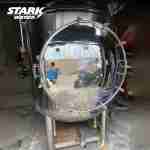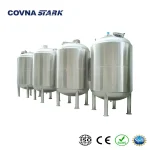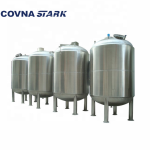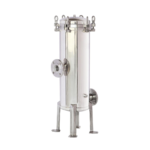Whether you're designing a water system for cooling, process water, wastewater treatment, or ingredient storage, selecting the right tank is critical. While water tanks may seem like simple components, poor tank selection can lead to operational inefficiencies, hygiene risks, and costly retrofits.
This article outlines the five most common mistakes buyers make when choosing industrial water tanks—and how you can avoid them by focusing on material compatibility, design logic, and long-term usability.
Mistake #2: Ignoring Drainage Design and Dead Zones
In industrial water systems, incomplete drainage is more than a nuisance—it’s a hygiene and maintenance hazard. Tanks with flat bottoms, internal ledges, or poorly positioned outlets often retain stagnant water or sludge, creating bacterial growth zones and complicating cleaning operations.
What to Look for:
- Conical or Sloped Bottoms: Ensure gravity-assisted drainage, especially for tanks handling wastewater or sediment-prone liquids.
- CIP-Friendly Design: Avoid sharp corners and recessed areas that standard spray balls or nozzles cannot reach.
- Bottom Outlet Positioning: Align outlet ports with the lowest drain point. Misaligned ports can leave up to 5–10% of the tank volume undrainable.
In processes that require frequent cleaning (such as food or pharmaceutical applications), tanks must be designed for full drainability and zero dead zones. Otherwise, you risk hygiene violations, product contamination, or excessive chemical use during CIP cycles.
Mistake #3: Oversizing or Undersizing the Tank Volume
Tank volume must be carefully matched to the flow rate, retention time, and operating cycles of your system. A tank that is too small can lead to overflow, pump cavitation, or frequent system interruptions. Conversely, an oversized tank increases footprint, cost, and cleaning time—without necessarily adding operational value.
Key Sizing Considerations:
- Peak vs. Average Flow: Design for peak flow conditions, but avoid oversizing purely for safety unless surge storage is required.
- Process Holding Time: For sedimentation, neutralization, or blending applications, calculate minimum residence time based on chemical or hydraulic requirements.
- Batch vs. Continuous Operation: Batch systems typically need larger buffer volumes; continuous systems benefit from compact, steady-flow tanks.
For example, in an RO pre-treatment system, an undersized raw water tank may trigger low-level pump shutdowns, while an oversized CIP tank can lead to long chemical fill and drain cycles. The key is to size for efficiency, not excess.
Mistake #4: Overlooking Structural Support and Installation Conditions
A perfectly designed tank can still fail—or cause delays—if installation conditions are not properly considered. Industrial tanks, especially those above 5,000 liters, require appropriate structural planning, anchoring, and access to ensure long-term stability and safe operation.
Common Oversights Include:
- Foundation Load Bearing: Concrete pads must be leveled and designed to withstand full tank weight, including dynamic forces from agitation or thermal expansion.
- Anchor Point Design: Tanks should be fitted with seismic or wind-load brackets in outdoor installations, particularly for tall or narrow vertical tanks.
- Transport Constraints: Oversized tanks may face access limitations during delivery or require craning equipment. Modular or sectional tanks can help in tight plant layouts.
- Clearance for Maintenance: Ensure space for top manhole access, lifting lugs, valve zones, and CIP spray ball inspection when planning tank placement.
Failing to account for these elements can delay commissioning, void warranties, or result in long-term structural stress. Always request tank drawings and load specifications before finalizing your foundation or procurement plan.
Mistake #5: Failing to Account for Cleaning and Maintenance Needs
One of the most overlooked aspects of tank design is how the tank will be cleaned and maintained over its lifecycle. Tanks that are difficult to access, drain, or sanitize can become operational liabilities—especially in industries with strict hygiene standards.
Maintenance-Friendly Design Elements to Consider:
- Manholes and Access Ports: Top and side manholes with sanitary gaskets allow for internal inspection, swabbing, or manual cleaning.
- CIP Compatibility: Spray balls or rotary nozzles should ensure 360° internal coverage with validated flow and impact pressure.
- Surface Finish: Mirror-polished or electropolished interiors (Ra ≤ 0.4 μm) minimize fouling and biofilm formation.
- Drain Orientation: A fully sloped bottom ensures zero fluid retention after cleaning or chemical neutralization cycles.
Neglecting these design features can increase cleaning time, chemical usage, and bacterial risk—especially in food, beverage, and pharmaceutical environments. Over time, this results in higher total cost of ownership (TCO) and regulatory compliance risks.
Conclusion: Choose With Function, Not Just Price
Industrial water tanks are more than just vessels—they are structural, hygienic, and operational assets within your process system. Selecting the right tank involves more than comparing prices or volumes. It requires a clear understanding of your application’s chemical compatibility, drainage requirements, volume logic, installation conditions, and cleaning standards.
At STARK, we help manufacturers, integrators, and EPC contractors choose water tanks that perform reliably under real-world conditions. Whether you need a sanitary-grade CIP tank, an FRP neutralization vessel, or a large-volume stainless steel storage system, we’ll support you from design to delivery.
Need help selecting a tank for your industrial project?
Contact our technical team to receive drawings, material recommendations, and cost-effective sizing guidance.





